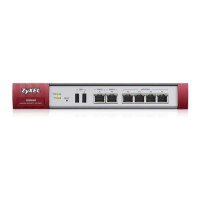Chapter 10 Interfaces
ZyWALL USG Series User’s Guide
385
Each field is described in the following table.
Table 127 Configuration > Network > Interface > LAG > Add
LABEL DESCRIPTION
General Settings
Enable Interface Select this to enable this interface. Clear this to disable this interface.
Interface Properties
Interface Type Select one of the following option depending on the type of network to which the Zyxel
Device is connected or if you want to additionally manually configure some related
settings.
internal is for connecting to a local network. Other corresponding configuration options:
DHCP server and DHCP relay. The Zyxel Device automatically adds default SNAT settings for
traffic flowing from this interface to an external interface.
external is for connecting to an external network (like the Internet). The Zyxel Device
automatically adds this interface to the default WAN trunk.
For general, the rest of the screen’s options do not automatically adjust and you must
manually configure a policy route to add routing and SNAT settings for the interface.
Interface Name This field is read-only if you are editing the interface. Enter the name of the LAG interface.
The format is lagx, where x is 0 - 3. For example, lag0, lag1, and so on.
Zone Select the zone to which the interface is to belong. You use zones to apply security settings
such as security policy, IDP, remote management, anti-virus, and application patrol.
Description Enter a description of this interface. You can use alphanumeric and
()+/:=?!*#@$_%-
characters, and it can be up to 60 characters long. Spaces are allowed, but the string
can’t start with a space.
LAG Configuration
Mode Select a Mode for this LAG interface. Choices are as follows:
• active-backup where only one slave in the LAG interface is active and another slave
becomes active only if the active slave fails.
• 802.3ad (IEEE 802.3ad Dynamic link aggregation) where Link Aggregation Control
Protocol (LACP) negotiates automatic combining of links and balances the traffic load
across the LAG link by sending LACP packets to the directly connected device that
also implements LACP. The slaves must have the same speed and duplex settings.
• balance-alb (adaptive load balancing) where traffic is distributed according to the
current load on each slave by ARP negotiation. Incoming traffic is received by the
current slave. If the receiving slave fails, another slave takes over the MAC address of
the failed receiving slave.
Link Monitoring Select from none, mii or arp. none means no link monitoring is done.
mii monitoring monitors the state of the local interface; it can’t tell if the link can transmit or
receive packets.
arp monitoring sends ARP queries and uses the reply to know if the link is up and that traffic
is flowing over the link.
Miimom This field displays for mii Link Monitoring. Set the link check interval in milliseconds that the
system polls the Media Independent Interface (MII) to get status.
Updelay This field displays for mii Link Monitoring. Set the waiting time in milliseconds to confirm the
slave interface status is up.
Downdelay This field displays for mii Link Monitoring. Set the waiting time in milliseconds to confirm the
slave interface status is down.
Xmit Hash Policy This field displays in 802.3ad Mode. This field sets the algorithm for slave selection according
to the selected TCP/IP layer.
LACP Rate This field displays in 802.3ad Mode. Select the preferred LACPDU packet transmission rate
(slow/fast) to request from 802.3ad partner.
ARP Interval This field displays for arp Link Monitoring. Select the frequency of ARP requests sent to
confirm a that slave interface is up.

